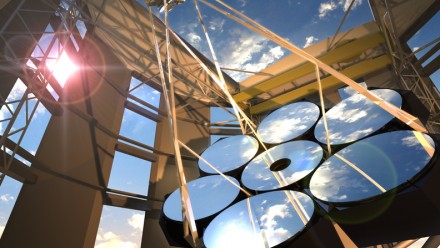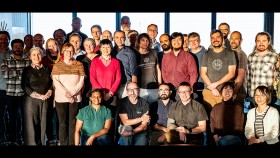Through the GMT we’re standing on the shoulders of giants
If Australia is to maintain its international reputation in astronomy and astrophysics (we currently punch way above our weight) we’re going to need access to the world’s next generation of giant telescopes. Thanks to Australian Government funding the country is now a partner in the Giant Magellan Telescope (GMT), currently being built high in the mountains of Chile. This will guarantee our astronomers a 10% share in what will be by far the largest and most powerful telescope the world has ever seen! Research at MSO is helping make the GMT dream a reality.
With seven giant 8-metre mirrors the effective aperture of the GMT will be a staggering 22 metres enabling it to collect almost ten times the light of current generation super-telescopes. But it’s not simply a matter of how much light can be collected. It’s as much about the precision with which that light can be collected, and this has traditionally been limited for ground-based telescopes by the turbulence in the Earth’s atmosphere. But advances in the field of advanced adaptive optics is changing all that and researchers at MSO are playing a key role in enabling the GMT to achieve very high-resolution images of the cosmos.
Adaptive optics involves deforming the mirrors to precisely cancel out distortions caused by atmospheric turbulence. It’s a serious technical challenge. MSO’s Dr Rodolphe Conan is an acknowledged expert in the field of adaptive optics and is currently the lead scientist working on the design of an adaptive optics package for the GMT.
Because the atmospheric structure changes thousands of times each second, it would be almost impossible to deform GMT’s massive primary mirrors quickly enough to compensate. Instead, adaptive secondary mirrors that will accomplish this task.
“These are still large mirrors,” observes Dr Conan. “But by mounting a fairly thin reflective surface over a backing plate with 672 individual actuators, we can deform them at very high speeds.”
But how do you know which way to bend the mirrors to compensate for the atmospheric distortions? One way is to use a natural guide star – a star that happens to be in the field of view of the object you’re looking at. You know the star is supposed to be an infinitesimally small point so you can work out from its actual shape and position what the atmosphere is doing and apply a correction.
In most cases, however, there isn’t a convenient natural guide star in just the right position so scientists use lasers to create artificial guide stars by exciting atoms such as sodium high in the upper atmosphere. On GMT there will be six laser-generated artificial guide stars. There are also seven secondary mirrors each with 672 movable actuators each one of which needs to move independently a thousand times every second.
“Developing a suitable algorithm to correct such a large wavefront and harnessing enough computing power to drive all those actuators is massive challenge,” comments Dr Conan says.
Dr Conan and his team at MSO expect the design phase of the GMT adaptive optics module to be complete by the end of 2011, at which point there will be a scientific review before proceeding to build the components of the system. The completed telescope is expected to see first light in around 2020.












